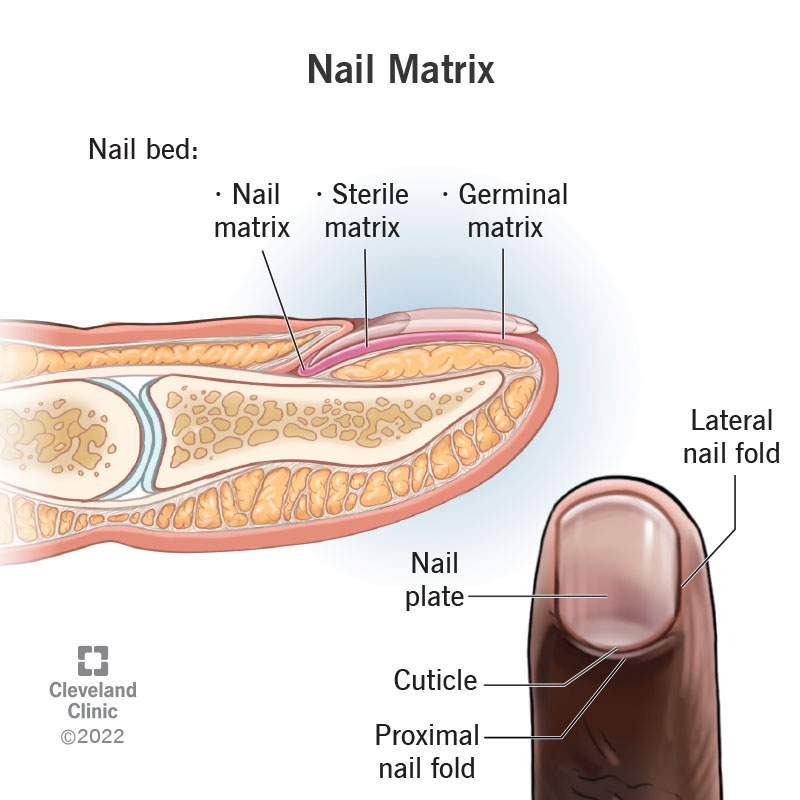Your nail matrix is where your fingernails or toenails form. A healthy nail matrix is essential for healthy nails. A variety of conditions and injuries can damage your nail matrix. But in many cases, your nail matrix will heal with proper care.
Advertisement
Cleveland Clinic is a non-profit academic medical center. Advertising on our site helps support our mission. We do not endorse non-Cleveland Clinic products or services. Policy

Your nail matrix is where your fingernails and toenails form. Your nail matrix has two parts: the germinal matrix and the sterile matrix.
Advertisement
Cleveland Clinic is a non-profit academic medical center. Advertising on our site helps support our mission. We do not endorse non-Cleveland Clinic products or services. Policy
Your nail matrix creates new cells that become your fingernails or toenails. About 90% of your nail growth comes from your germinal matrix. Your sterile matrix is responsible for the remaining 10% of cells that make up your fingernails and toenails, but is more important in keeping your nail attached to the underlying skin.
Injuries and certain health conditions can damage your nail matrix and interfere with nail growth. Minor damage to your nail matrix can temporarily change your nail’s appearance. You might notice:
A severe injury could cause your nail to fall off. Once your nail matrix heals, your nail will usually start to grow again. It may take several weeks before you see your new nail appear. In cases of severe nail matrix damage, some or all of your nail may not grow back.
Your nail’s germinal matrix is under the base of your nail, and the sterile matrix lies underneath your nail. You can’t see most of your nail matrix. The lunula (white crescent shape at the base of your nail) is the only visible part of your nail matrix. But some people don’t have visible lunulas, and that’s normal, too.
The nail matrix and lunula are part of your nail’s overall structure, which also includes your:
Advertisement
Your nail matrix is made of special cells whose main job is to make new fingernails or toenails. Each nail matrix produces 196 layers of cells that combine to make each of your fingernails and toenails. Each nail matrix is constantly making new nail cells, unlike your hair follicles, which go through periods of rest.
Some health conditions and other factors can affect your nail matrix, including:
Additionally, certain skin conditions and diseases can affect your nail matrix, such as:
Any change to the appearance or texture of one or more of your nails could be a sign of a nail matrix problem. If you have nail matrix damage or a condition affecting your nail matrix, your nails may have:
It can be difficult to tell the difference between a harmless nail change and one that requires treatment. If you notice any change to your fingernails or toenails, see a healthcare provider. They can determine the cause and recommend treatment, if needed.
Advertisement
Not all nail changes mean your nail matrix is damaged. Some nail problems affect the nail bed, nail plate or nail folds, and not your nail matrix.
Your healthcare provider can tell you whether it’s a nail matrix problem or some other issue. Let your provider know if you notice any nail changes, from a small spot of color to lines or ridges.
Treatment for a nail matrix condition depends on the cause. For example, your provider may recommend:
Advertisement
Accidents happen, so you can’t always prevent a nail matrix injury. But you can help prevent problems with your nail matrix if you:
Advertisement
Your nail matrix is the “factory” where your body makes new fingernails and toenails. Certain injuries and illnesses can damage your nail matrix and affect how your nails look or grow. But with the right treatment, you can often see healthy nails grow again. Even if your nail falls off, it usually grows back with proper medical care.
It’s rare for your nail matrix to be permanently damaged, preventing your nail from growing back. But if this happens, ask your provider if you should protect your finger or toe during physical activity. Over time, you’ll likely get used to your nail being gone. Remember that you can still live a full, active life without a fingernail or toenail.
Cleveland Clinic’s primary care providers offer lifelong medical care. From sinus infections and high blood pressure to preventive screening, we’re here for you.

Last reviewed on 02/14/2023.
Learn more about the Health Library and our editorial process.